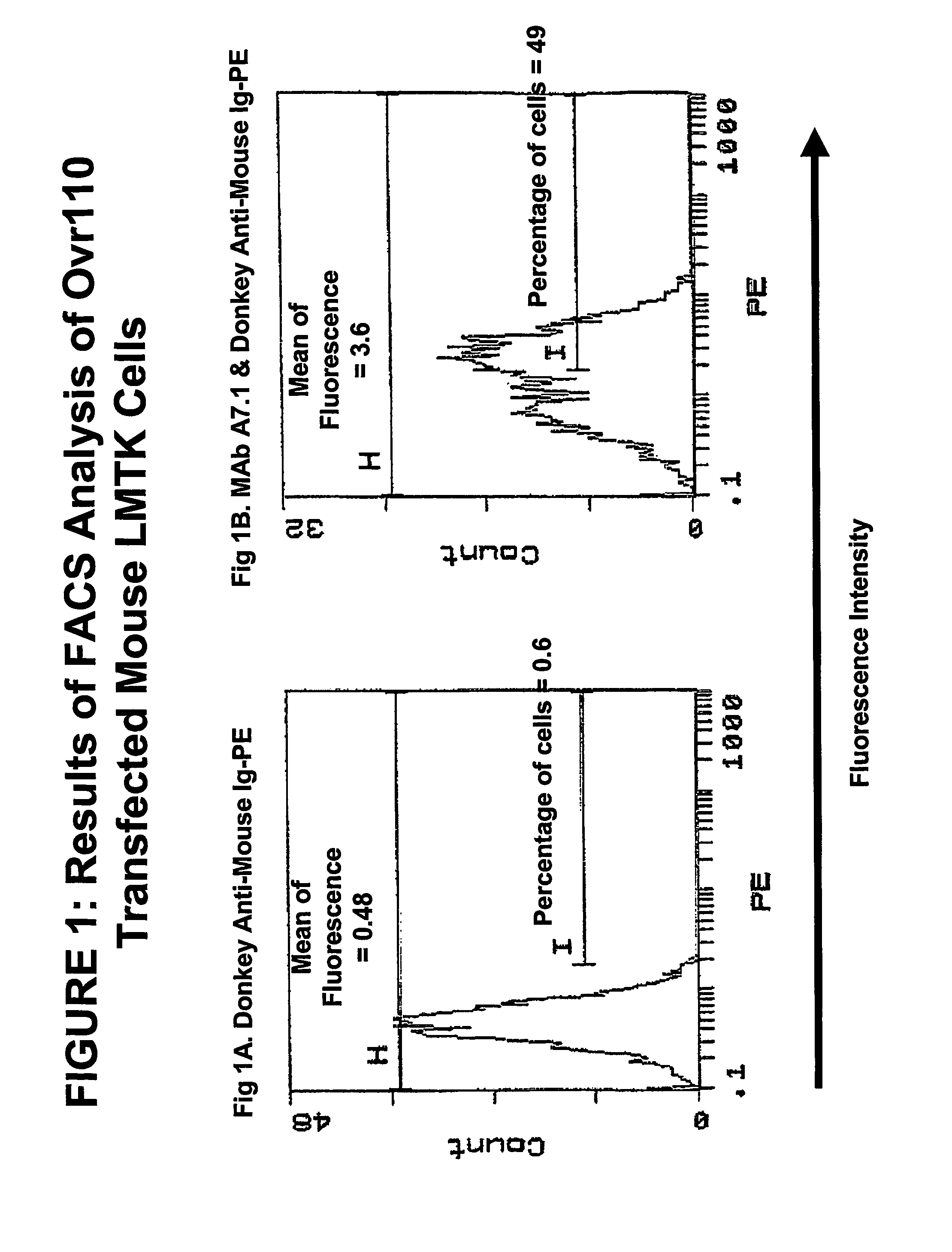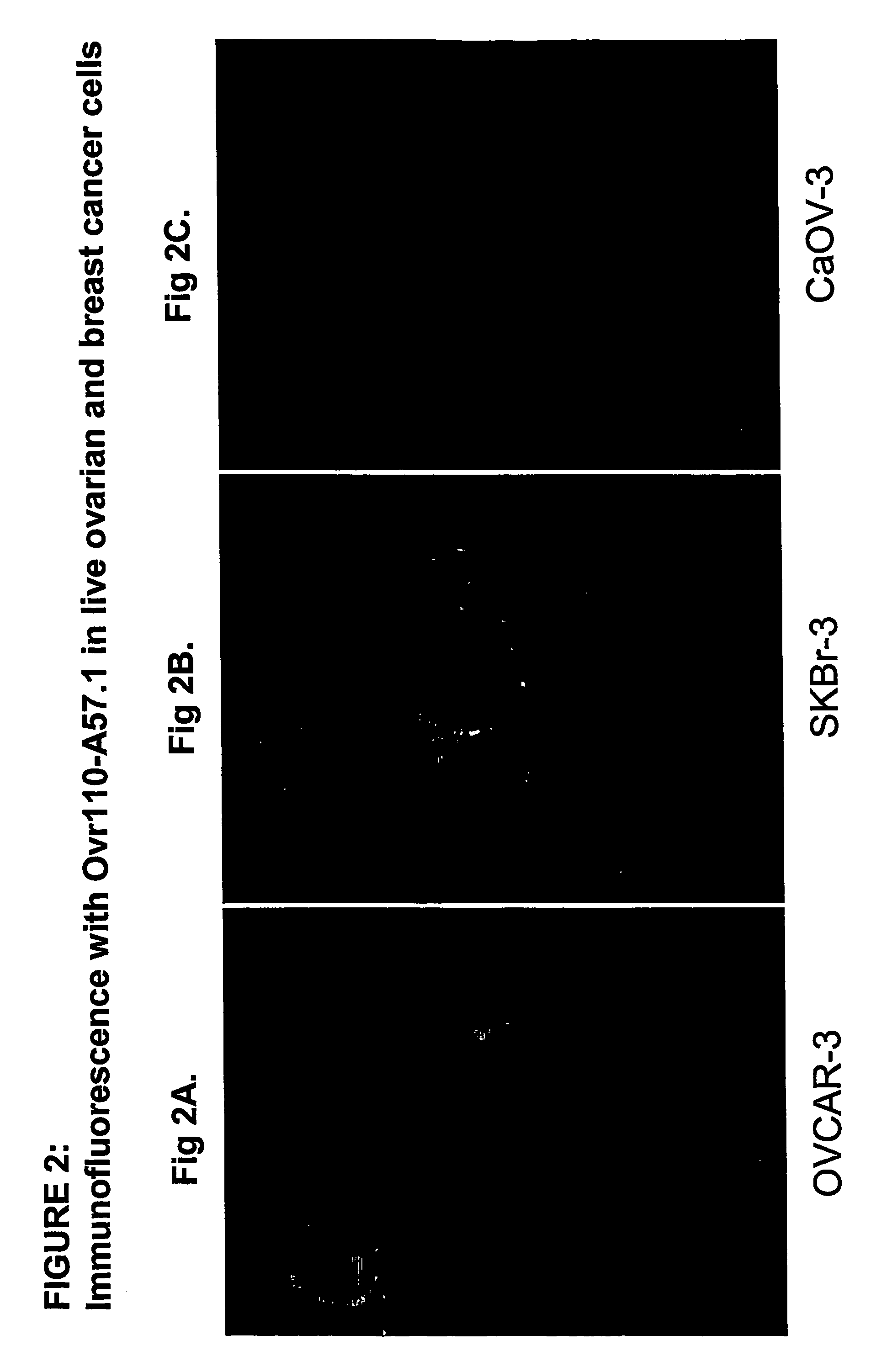Ovr110 antibody compositions and methods of use
a technology of ovr110 and composition, which is applied in the field of antiovr110 antibody composition, can solve the problems of increasing or reducing the risk of ovarian cancer, affecting the diagnostic ability of ovarian cancer screening procedures, and atypical women with ovarian cancer, and achieves the effect of enhancing tumor xenograft growth
- Summary
- Abstract
- Description
- Claims
- Application Information
AI Technical Summary
Benefits of technology
Problems solved by technology
Method used
Image
Examples
example 1
Production and Isolation of Monoclonal Antibody Producing Hybridomas
[0291]The following MAb / hybridomas of the present invention are described below:
[0292]Ovr110.A7.1, Ovr110.A10.1, Ovr110.A13.1, Ovr110.A31.1, Ovr110.A57.1, Ovr110.A72.1 (previously identified as Ovr110 A22.1), Ovr110.A77.1, Ovr110.A87.1, Ovr110.A89, Ovr110.A 99.1, Ovr110.A102.1, Ovr110.A107, Ovr110.C1, Ovr110.C2, Ovr110.C3.2, Ovr110.C4, Ovr110.C5.1., Ovr110.C5.3, Ovr110.C6.3, Ovr110.C7.1, Ovr110.C8, Ovr110.C9.1, Ovr110.C10.1, Ovr110.C11.1, Ovr110.C12.1, Ovr110.C13, Ovr110.C14, Ovr110.C15, Ovr110.C16.1 and Ovr110.C17.1. If the MAb has been cloned, it will get the nomenclature “X.1,” e.g., the first clone of A7 will be referred to as A7.1, the second clone of A7 will be referred to as A7.2, etc. For the purposes of this invention, a reference to A7 will include all clones, e.g., A7.1, A7.2, etc.
Immunogens and Antigens Recombinant Proteins, HA & His Tags & Transfected Cells)
[0293]Ovr110A Sequence & Protein Production
[02...
example 2
Cell Surface Binding of Ovr110 MAbs in Live Cancer Cells Demonstrated by Immunofluorescence
[0353]The following cancer cell lines were used in this study: Ovarian OvCar-3, ovarian CaOV-3 and breast SKBr-3. OvCAR-3 and SKBR-3 cells but not the control CaOV-3 cells express Ovr110.
[0354]Cells were seeded on 18 mm glass coverslips and cultured at 37° C. in DMEM containing 10% fetal bovine serum and penicillin and streptomycin for 48 hr prior to treatment with the anti-Ovr110 MAbs.
[0355]Eleven Ovr110 MAbs (Ovr110.A7.1, Ovr110.A13.1, Ovr110.A72.1, Ovr110.A31.1, Ovr110.A57.1, Ovr110.A77.1, Ovr110.A87.1, Ovr110.A89.1, Ovr110.A99.1, Ovr110.A102.1 and Ovr110.A107.1) were tested to determine which antibody binds to the cell surface of Ovr110 expressing cancer cells. Primary MAbs were added to the medium at a final concentration of 10 ug / ml and incubated for one hour at 37° C. Following fixation with 3% formaldehyde in Phosphate Buffered Saline (PBS), the cells were incubated with a secondary Cy...
example 3
Killing of Ovr110 Transfected CHO Cells by Incubation with MAbs and Anti-Mouse MAb Saporin Conjugate
[0381]Experiments were performed by incubating Ovr110 transfected CHO cells (Ovr110-CHO) with Ovr110 Mabs premixed with Mab-zap goat anti-mouse Ig saporin conjugate (Advanced Targeting Systems, San Diego, Calif.) and measuring cell viability at 72 and 96 h, to detect potential killing effects on these Ovr110 expressing cells. On day 1, Ovr110-CHO cells were placed into 96 well, flat bottom, sterile cell culture plates (Corning), in triplicate wells, at 2000 cells / 75 uL / well, in F12 medium with 10% FBS, P / S. Plates were incubated at 37° C., in 5% CO2, overnight. Duplicate plates were set up to allow readings at 72 h and 96 h. On Day 2 (0 h), 25 uL of 4× final MAb concentrations alone, or 25 uL of 4×MAb premixed with 25 uL of 4×Mab Zap, or 25 uL of 4×Mab Zap alone, or 25 uL of medium alone were added to wells of the 96 well plates, in triplicate, to a final volume of 100 uL. Final MAb c...
PUM
| Property | Measurement | Unit |
|---|---|---|
| size | aaaaa | aaaaa |
| concentration | aaaaa | aaaaa |
| molecular weight | aaaaa | aaaaa |
Abstract
Description
Claims
Application Information
 Login to View More
Login to View More - R&D
- Intellectual Property
- Life Sciences
- Materials
- Tech Scout
- Unparalleled Data Quality
- Higher Quality Content
- 60% Fewer Hallucinations
Browse by: Latest US Patents, China's latest patents, Technical Efficacy Thesaurus, Application Domain, Technology Topic, Popular Technical Reports.
© 2025 PatSnap. All rights reserved.Legal|Privacy policy|Modern Slavery Act Transparency Statement|Sitemap|About US| Contact US: help@patsnap.com



